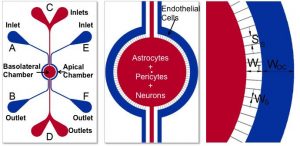Researchers at Temple University used the SynVivo® cell-based in vitro assay platform to model the attributes and functions of the neonatal stage blood-brain barrier (BBB) [1]. The SynVivo BBB model closely mimics the in vivo microenvironment including three-dimensional morphology, cellular interactions, and flow characteristics on a microfluidic chip. This work marks the first dynamic in vitro neonatal BBB model that offers real-time visualization and analysis and is suitable for studies of BBB function as well as a screening of novel therapeutics.
“The work is important because studies of neonatal neuropathologies and development of appropriate therapeutics are hampered by a lack of relevant in vitro models of the neonatal blood-brain barrier,” said Dr. Sudhir Deosarkar, the lead author of this paper.
In the SynVivo-BBB model, which includes a tissue compartment and vascular channels placed side-by-side and separated by an engineered porous barrier, the researchers were able to co-culture neonatal rat brain endothelial cells and rat astrocytes under physiological conditions observed in vivo. The endothelial cells formed a full lumen and exhibited tight junction formation which increased under co-culture with astrocytes. The permeability of small molecules in the developed model was found in excellent agreement with in vivo observations.

“The real-time visualization capabilities of the co-culture platform allowed, for the first time, visualization of astrocyte end-feet and endothelial cell interactions in anin vitro model,” said Prof. Mohammad Kiani who is the senior author of the paper. “This is a unique capability and will help us to understand and develop therapeutics for several developmental disorders and diseases of the brain.”
The PLOS ONE paper shows that in contrast to transwell models, the SynVivo based model exhibits significantly improved barrier characteristics similar to in vivo observations.
1A Novel Dynamic Neonatal Blood-Brain Barrier on a Chip. S. Deosarkar, B. Prabhakarpandian, B. Wang, J.B. Sheffield, B. Krynska, M. Kiani. PLOS ONE, 2015, DOI: 10.1371/journal.pone.0142725